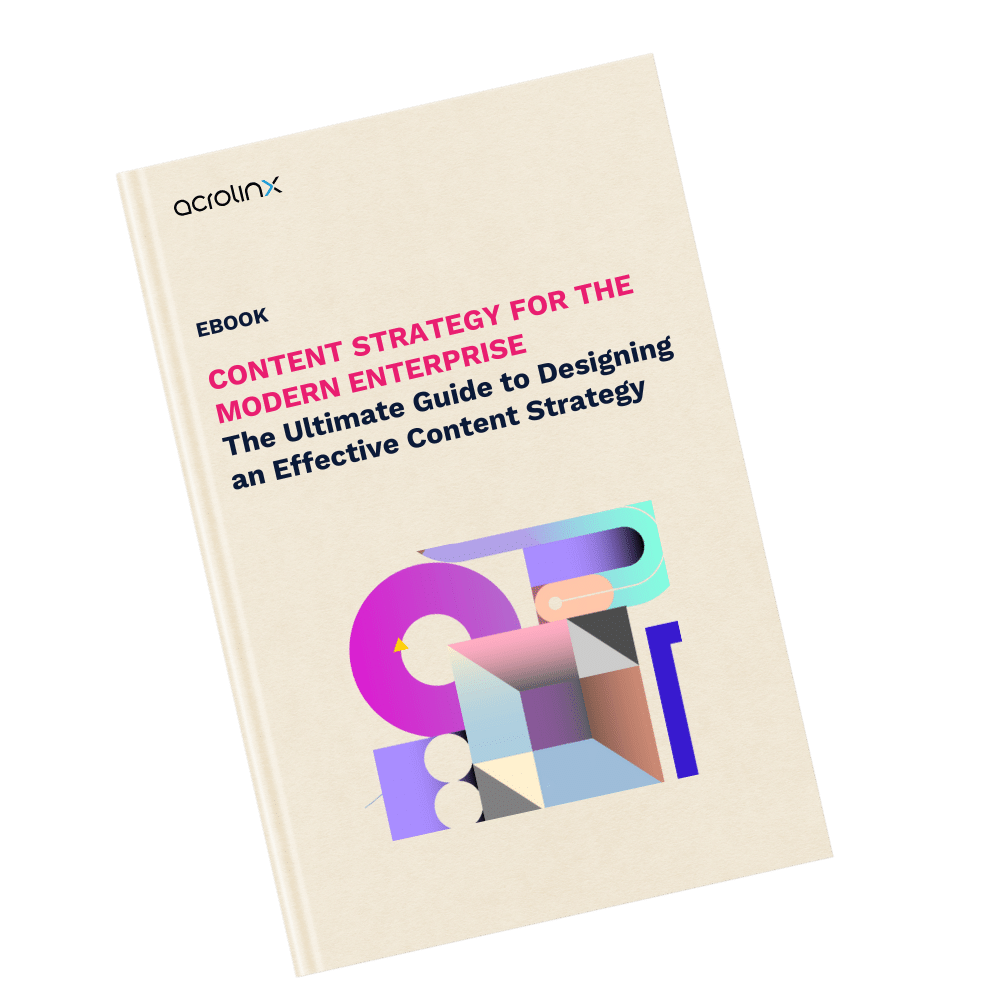The Content Ecosystem: Building AI Workflows That Scale For Enterprise Teams

How does your enterprise manage its content at scale? Are your teams struggling to keep up with growing demands, or are inefficiencies slowing down production? In today’s digital landscape, enterprise teams face the challenge of managing complex content ecosystems.
Integrating Artificial Intelligence (AI) into content workflows offers a solution to scale operations efficiently, improve consistency, and drive business value. This blog explores the concept of a content ecosystem and gives insights into building AI workflows that scale for enterprise teams. Let’s dive in!
What’s a content ecosystem and why does it matter?
A content ecosystem comprises all elements involved in the creation, management, distribution, and analysis of content within an enterprise. This includes various:
- Content types: Blogs, videos, podcasts, whitepapers, infographics, and more, each serving different audience needs and engagement strategies.
- Platforms: Websites, social media channels, email marketing platforms, and internal content hubs where content is published and shared.
- Tools: AI-powered writing assistants, content management systems (CMS), SEO optimization tools, analytics platforms, and workflow automation software that streamline content production and governance.
- Technologies: Machine learning algorithms for personalization, Natural Language Processing (NLP), digital asset management (DAM) systems for efficient storage, and automation tools that maintain consistency and compliance across content assets.
- Teams responsible for these processes: Content strategists, writers, designers, marketers, and compliance specialists who collaborate to achieve high-quality, effective content delivery.
Understanding this ecosystem is crucial for several reasons:
Maintaining consistency
Maintaining a unified brand voice across all channels is critical for enterprise teams operating at scale. A fragmented content ecosystem leads to mixed messaging and reduced brand trust. Establishing clear brand guidelines and governance frameworks keeps messaging aligned, reinforces brand credibility, and improves customer confidence.
Increasing efficiency
Streamlining content workflows reduces redundancies and improves resource allocation. Businesses should invest in a central content management system (CMS). This system should make collaboration easy, automate workflows, and manage versions. These features will help prevent duplicate work. This supercharges productivity and frees up teams for higher-value strategic work.
Achieving scalability
As businesses grow, their content needs to expand across markets, languages, and channels. A well-structured content system helps enterprises grow. It uses AI to automate routine tasks like tagging, categorization, and content recommendations. This means businesses can enter new markets and scale their content supply chain without exponentially increasing costs.
Mapping your content: Understanding the foundations of an AI-driven content ecosystem
Before integrating AI, it’s essential to map your existing content ecosystem. This process involves the following steps:
Step 1: Inventory assessment
Catalog all content assets, including written, visual, and multimedia content. Use content governance software to analyze existing content performance and identify gaps where automation can improve efficiency. This visibility helps enterprises reduce redundant content creation and make data-driven decisions.
Step 2: Workflow analysis
Identify bottlenecks in content creation, approval, and distribution processes. AI streamlines these workflows by automating repetitive tasks, such as proofreading, compliance checks, and content reuse. The result? Faster content delivery and lower operational costs.
Step 3: Technology audit
Evaluate your current content management and AI tools to make sure they’re compatible and scalable. Consider AI-powered platforms that integrate seamlessly with your CMS, CRM, and marketing automation tools to improve efficiency across departments. This means that your tech stack evolves with your business needs instead of creating silos.
Key components of a scalable content ecosystem
A scalable content ecosystem consists of several critical components:
Component Business value Modular content Enables easy repurposing across platforms, saving time and resources. Metadata management Improves searchability and automation. It makes sure people easily find and categorize content. Integrated solutions Provides a seamless workflow between CMS, DAM, and analytics tools, reducing inefficiencies. Content governance Safeguards your content against communication risks introduced by content that’s off brand, unclear, or inconsistently applies enterprise-specific terminology.
Why content governance is a must have
Content governance is a systematic approach to managing and overseeing your company’s content strategy. It includes capturing and organizing content, measuring its performance, guiding content creation to meet goals, and maintaining its quality and relevance over time. Effective content creation and governance are vital for maintaining quality and compliance across large-scale enterprises:
- Standardized guidelines: Establish detailed content creation, review, and approval processes to maintain quality. AI-powered style guides and compliance tools, such as Acrolinx, automatically scan, score, and fix content for adherence to brand and regulatory standards. This minimizes the risk of errors and maintains a professional brand image.
- Role definition: Clearly define responsibilities to avoid overlaps and encourage accountability. AI assists by providing workflow automation that assigns tasks based on team member expertise and workload. This optimizes efficiency and keeps projects on track.
- Compliance monitoring: Enterprises operating in regulated industries must ensure content aligns with industry standards. AI highlights potential compliance issues in real time, reducing the risk of errors and legal complications. This protects your enterprise from costly fines and reputational damage.
AI workflows for content optimization
Integrating AI into content workflows offers numerous benefits for enterprises looking to scale efficiently.
Automated content generation
AI-powered writing tools generate content drafts, social media posts, and product descriptions, freeing up human creators for strategic work. However, human oversight is essential to refine AI-generated content for brand alignment and tone consistency, preventing off-brand messaging.
Personalization
AI analyzes user behavior to deliver tailored content experiences. For example, recommendation engines dynamically adjust website content or email campaigns based on past interactions, improving engagement rates. This leads to higher conversion rates and increased customer retention.
Predictive analytics
AI forecasts content performance by analyzing trends, audience behavior, and past engagement metrics. This helps marketing and content teams prioritize high-performing topics and optimize content for better reach. Investing in AI-powered analytics and reporting means enterprises can proactively create content that resonates with their audience.
Multilingual and global content management
For global enterprises, managing content in multiple languages is a significant challenge. AI-powered solutions simplify this process:
- AI-powered translation: Machine translation tools, combined with human oversight, deliver consistent messaging across languages. AI also provides adjustments based on cultural nuances and regional preferences, reducing localization costs and turnaround time.
- Cultural adaptation: AI tools analyze linguistic and cultural variations to localize content effectively. This goes beyond translation by adapting imagery, tone, and messaging to resonate with different audiences, increasing market penetration and customer satisfaction.
- Centralized management: A global content hub centralizes multilingual content, making it easier to manage updates, compliance, and approvals across regions. AI can automate content synchronization across multiple platforms, reducing the burden on local teams.
The challenges of scaling a global content ecosystem
Scaling content operations globally presents several challenges that enterprises must navigate. Managing a global content team requires balancing internal and external resources, and AI-powered content planning tools allocate tasks efficiently based on team availability and expertise. This prevents bottlenecks and improves team productivity. Maintaining brand consistency across diverse markets is another hurdle, requiring governance tools that monitor tone, style, and formatting.
AI compliance solutions catch inconsistencies before publication, protecting brand reputation. Especially when enterprises must navigate different legal requirements, such as data privacy laws and accessibility standards. AI assists by automatically detecting compliance risks and suggesting content modifications to meet regulatory guidelines, reducing legal risk.
Steps for building an AI-powered content ecosystem that scales
To build a scalable, AI-driven content ecosystem, enterprise teams should follow these steps:
- Assess current state: Conduct a comprehensive content audit to identify inefficiencies, gaps, and areas for AI-driven improvements. This establishes a clear timeline for AI adoption and maximizes ROI.
- Define objectives: Set clear goals, such as improving content velocity, improving personalization, or automating compliance checks. Align these objectives with overall business and marketing strategies to drive measurable impact.
- Select appropriate tools: Choose AI solutions that integrate seamlessly with your content stack. Consider AI-driven CMS platforms, translation tools, and content governance software like Acrolinx to boost efficiency.
- Train teams: Equip content teams with the necessary skills to work alongside AI. Provide training on AI best practices, data interpretation, and human-AI collaboration to optimize workflows.
- Monitor and iterate: Continuously track performance metrics and AI effectiveness. For long-term success, use feedback loops to refine AI models and improve processes over time.
By following these steps, enterprise teams harness AI to create a content ecosystem that’s both efficient and scalable. AI-driven content operations enable enterprises to meet the growing demands of a global audience while maintaining quality, compliance, and strategic alignment.
Acrolinx: Helping you build AI workflows that scale
A key challenge in scaling AI-powered content ecosystems is balancing automation with human oversight, particularly in regulated industries. Acrolinx supports this balance by aligning your content with corporate and regulatory standards — whether for marketing materials, product documentation, or customer communications.
As enterprises adopt AI to optimize workflows, Acrolinx provides the essential governance layer that makes sure AI-generated content meets business and compliance requirements. With Acrolinx, your enterprise can confidently expand your content strategies across global markets, keeping every piece of content clear, consistent, and compliant.
Ready for a more scalable and efficient AI-driven content ecosystem? Join our biweekly product demo webinar to learn more.
Are you ready to create more content faster?
Schedule a demo to see how content governance and AI guardrails will drastically improve content quality, compliance, and efficiency.

Kiana Minkie
She comes to her content career from a science background and a love of storytelling. Committed to the power of intentional communication to create social change, Kiana has published a plethora of B2B content on the importance of inclusive language in the workplace. Kiana, along with the Acrolinx Marketing Team, won a Silver Stevie Award at the 18th Annual International Business Awards® for Marketing Department of the Year. She also started the Acrolinx Diversity and Inclusion committee, and is a driving force behind employee-driven inclusion efforts.





